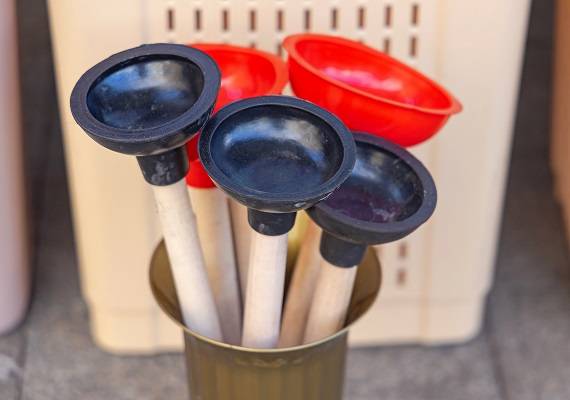Drain clogs can derail anyone’s day. Luckily, more often than not, small drain clogs can be fixed with one simple, common tool: the plunger. When you experience a clogged drain in your home, the first step to fix it is often to use a plunger. If that doesn’t work, then it’s time to call All Ways Drains, a plumber for your Mounds View home.
If your drain is clogged, and you aren’t quite sure how to go about trying to use a plunger yourself, we’ve made a quick guide for you on which plunger to use and how to use it!
Types of Plungers
There are three main types of plungers available to homeowners, and each works best in specific settings. It can be important to choose the right plunger for the location of your clog.
Standard Plunger

The standard plunger is what most people think of when they imagine a plunger. It consists of a rubber cup at the end of a straight handle, typically made from wood. Standard plungers are typically considered sink plungers, as flat surfaces like in a sink are required for this plunger to work effectively. Due to the flatness of the cup, the surface should be flat for best results with this plunger.
Toilet Plunger
The toilet plunger has a cup, like the sink plunger, but with a soft rubber flap that folds out from the inside of the cup. Otherwise known as the flange plunger, the toilet plunger is best for toilets. The fold out flap allows for better suction to be created when not on a flat surface.
One benefit to the toilet plunger is that you can fold the flap up in a pinch and use this plunger on a sink or flat surface as well.
Accordion Plunger
The least versatile of the plungers, the accordion plunger, has a smaller cup and is made from plastic that is quite hard, making it more difficult to use. It’s design only lends itself to use on toilets, but it is the most powerful of the plungers mentioned.
How to Use a Plunger
1. Examine the drain. Is there something else that could be causing the clog? Such as a drain stopper collecting hair, soap or other debris on the stem.
2. Block the overflow opening. Are you trying to unclog a bathtub or sink? First you must then block the overflow opening. This is normally located near the top of the sink rim or front wall of a bathtub and can be blocked with a wet rag.
3. Position the plunger. Place the plunger cup over the drain opening. If using in a sink or tub, run a little bit of water to cover the cup of the plunger.
4. Pump the handle. Use the handle of the plunger to thrust it up and down. Maintain the seal of the plunger throughout this process.
5. Check for drainage. After about six pumps of the plunger, pull the plunger away and check for drainage. If there is drainage, you have loosened the clog! If not, then repeat the process of plunging. If it doesn’t work after a few tries, then plunging may not be enough to solve this clog.
6. Flush the drain. The final step once you’ve unclogged a drain, specifically a sink or tub drain, is to flush it. Run hot water for a few moments to flush any lingering debris down to prevent new clogs from forming.
Using a Plunger Didn’t Work – Now What?
If using the correct type of plunger didn’t work, then you have two steps:
First, you could try using a drain snake in case the clog was just a little further down the pipe.
If that doesn’t work, then the final step is to call All Ways Drains, your plumber in Mounds View and surrounding areas. For stubborn clogs that you just can’t clear, call us today at 612-922-9422 or request a free estimate!
